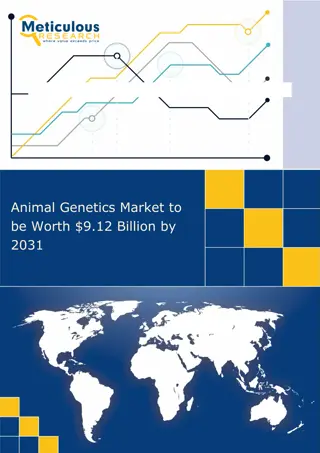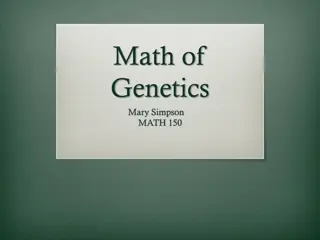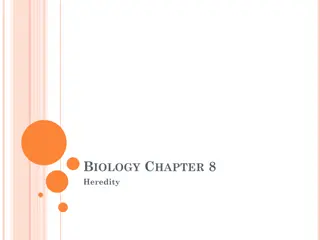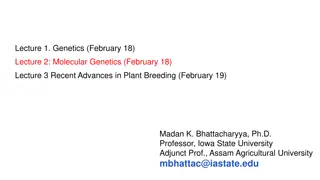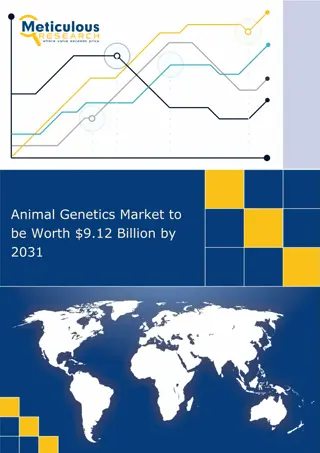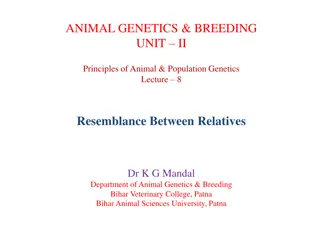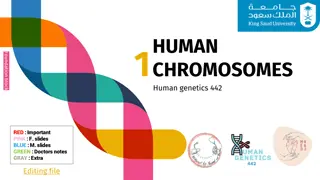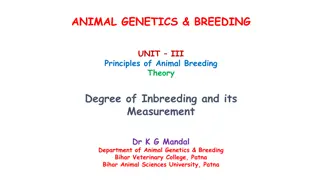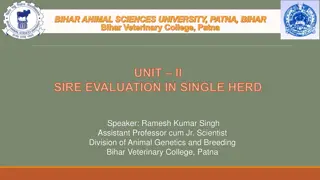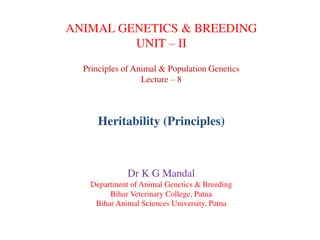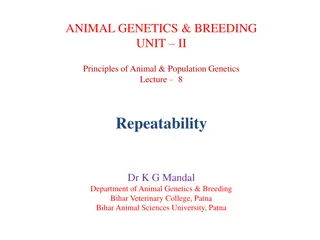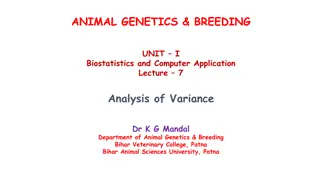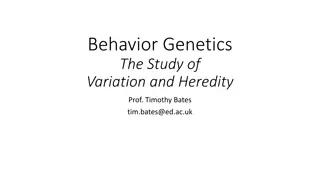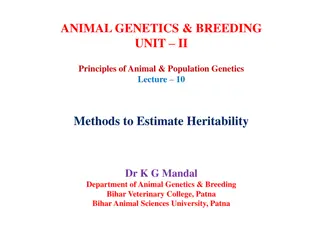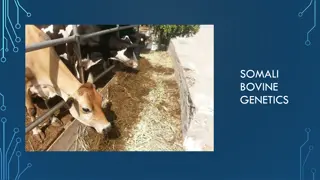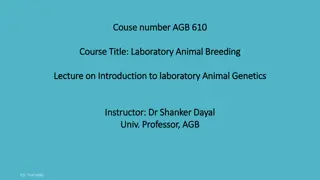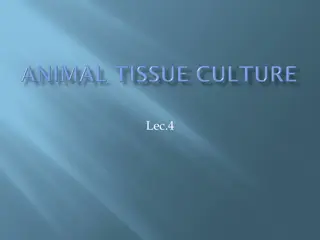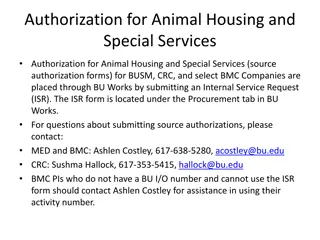Responsibilities of Facility Animal Care Committee at McGill University
The Facility Animal Care Committee (FACC) at McGill University oversees animal activities, ensures ethical treatment of animals, and adheres to guidelines from organizations such as the Canadian Council on Animal Care (CCAC). Responsibilities include continual oversight of animals, approving care pr
1 views • 13 slides
Animal Genetics Market
Explore $9.12 Billion Animal Genetics Market: Get exclusive insights on key market trends, segments, geographical analysis, & competitive analysis!
1 views • 5 slides
Animal Welfare and Ethics: Standards and Regulations in India
The content covers a wide range of topics related to animal welfare, ethics, and laws in India. It delves into the definition of animal welfare, the role of veterinarians, animal welfare organizations, regulations like the Prevention of Cruelty to Animals Act, and protection of wildlife, working ani
0 views • 15 slides
Exploring the Basics of Genetics and Inheritance
Understanding the fundamentals of genetics and inheritance, this content covers topics such as Mendelian genetics, gene inheritance, chromosomes, alleles, and Gregor Mendel's pioneering work. It delves into genetic outcomes related to multiple traits, linkage, dominance, Hardy-Weinberg equations, an
0 views • 87 slides
Understanding Mendel's Experiments and Principles of Genetics
Delve into the pioneering work of Gregor Mendel, the father of genetics, as he conducted groundbreaking experiments with pea plants, identified key principles of genetics, and introduced the concept of dominant and recessive traits. Explore how Mendel's work laid the foundation for our understanding
4 views • 23 slides
Understanding Genetics: The Key Concepts and Applications
Genetics is a vital field of biology focusing on genes, heredity, and genetic variation. This branch of science has deep roots in human history, influencing agriculture and shaping biological disciplines like evolution and developmental biology. Key subdisciplines include transmission genetics, mole
0 views • 26 slides
Genetics and Molecular Biology Lecture Series by Dr. Madan K. Bhattacharyya
Explore a comprehensive lecture series covering Genetics, Molecular Genetics, and Recent Advances in Plant Breeding by expert Dr. Madan K. Bhattacharyya. Delve into topics such as gene structure, transcription, translation, and the central dogma of molecular biology through informative visuals and v
2 views • 46 slides
Principles of Animal Breeding: Introduction and Historical Perspective
This unit covers the introduction to animal breeding, the application of genetics principles in breeding, historical perspectives including the work of Robert Bakewell, and key events in animal breeding evolution. Topics include breeding systems, importance of animal breeding, and notable figures in
1 views • 12 slides
The Impact of Regulatory Changes on the Animal Genetics Market
Explore $9.12 Billion Animal Genetics Market: Get exclusive insights on key market trends, segments, geographical analysis, & competitive analysis!\n
0 views • 5 slides
Importance of Training in Animal Care and Use for Research
Training in animal care and use is essential to ensure humane and appropriate treatment of research animals, promote regulatory compliance, and uphold high standards of science and animal well-being. The presentation covers the necessity of training, goals including reviewing animal use and identify
0 views • 53 slides
Understanding Animal Genetics: A Comprehensive Overview
Animal genetics is the study of heredity, inheritance of traits from parents to offspring, genetic material like DNA, chromosomes, genes, alleles, and nucleotides. It involves the understanding of chromosomes in different livestock species, DNA as the carrier of genetic information, genes as units o
0 views • 67 slides
Understanding Resemblance Between Relatives in Animal Genetics & Breeding
Explore the concept of resemblance between relatives in animal genetics, including direct and collateral relatives who share common genes. Learn how genetic similarities manifest in related individuals and the significance of measuring degrees of resemblance for estimating genetic variance and herit
0 views • 24 slides
Understanding Genetics in Agriculture: Virtual Revision Paper 2
Studying genetics plays a crucial role in agriculture and animal husbandry, aiding farmers in making informed breeding decisions for livestock and plant cultivars. This comprehensive overview covers the basics of genetics, terminology, methods for illustrating crosses, dihybrid crosses, and more, pr
0 views • 37 slides
Understanding the Difference: Animal Rights vs. Animal Welfare
Explore the nuanced distinction between animal rights and animal welfare, delving into the ethical considerations, philosophies, and advocacy efforts surrounding these concepts. Discover how animal rights proponents emphasize the equal rights of animals, while animal welfare focuses on humane treatm
0 views • 36 slides
SRAP Markers: Feasible Tool for Invasion Genetics of Freshwater Fish
Molecular tools, like Sequence-Related Amplified Polymorphism (SRAP) markers, play a crucial role in studying invasion genetics of freshwater fish. SRAPs offer a reliable and efficient way to assess genetic diversity and variations in non-native species, aiding in population genetics studies of inva
1 views • 5 slides
Understanding Human Chromosomes and Genetics in Health and Disease
Human chromosomes play a crucial role in genetics, ranging from heredity to disease. Cytogenetics studies their structure and behavior, essential for diagnostics like prenatal testing and identifying genetic disorders. The coiling and folding of DNA within chromosomes, along with the mitotic cell cy
0 views • 15 slides
Principles of Animal Genetics and Breeding in Farm Animals
Explore the fundamentals of animal genetics and breeding with a focus on inheritance, variation, and genetic improvement in farm animals. Learn how genetics principles, population genetics, and molecular genetics play a vital role in enhancing livestock production. Discover the economic traits in ca
1 views • 16 slides
Understanding Average Gene Effect and Breeding Value in Animal Genetics
In the field of animal genetics and breeding, it is crucial to comprehend the average effect of genes and breeding value of individuals. Genes are transmitted from parents to offspring through haploid gametes, influencing the genotype and breeding potential. Estimating the average effect of a gene i
4 views • 26 slides
Design of Experiment in Animal Genetics & Breeding: Principles and Methods
Biostatistics and computer applications play a key role in the design of experiments in animal genetics and breeding. Proper allotment of treatments to experimental units is crucial to study treatment effects accurately. Designing experiments helps in maximizing information from available resources,
0 views • 37 slides
Understanding Degree of Inbreeding and its Measurement in Animal Genetics and Breeding
Degree of inbreeding in animals is the extent to which genes are identical by descent within an individual. The coefficient of inbreeding, denoted by F, measures this degree and represents the increase in homozygosity in offspring from closely related matings. Two sources of homozygosity are genes a
0 views • 15 slides
Contrasting Qualitative and Quantitative Traits in Genetics
Genetic traits in organisms can be qualitative or quantitative, with qualitative traits controlled by single genes and showing distinct variations, while quantitative traits are influenced by multiple genes and environmental factors, resulting in continuous variations. Qualitative genetics focuses o
0 views • 13 slides
Understanding Statistics in Animal Genetics and Breeding
Statistics plays a crucial role in analyzing numerical information in the field of Animal Genetics and Breeding. This article introduces the meaning of statistics, its importance, and its application in various fields. It explains how statistics help in presenting data, making logical inferences, an
0 views • 20 slides
Understanding Quantitative Genetics Principles in Animal Breeding
Quantitative genetics focuses on the inheritance of characteristics based on degree rather than kind, compared to qualitative genetics. It involves polygenes controlling quantitative traits, which exhibit continuous variation and can be measured using metric units. Qualitative traits, on the other h
0 views • 22 slides
Understanding Sire Evaluation Methods in Animal Genetics
Sire evaluation plays a crucial role in determining genetic worth and breeding value in animal genetics. Various methods such as Sire Index, Daughter Average Index, and Equiparent Index are used to assess sires for genetic superiority. Biasness in evaluation due to environmental factors and contempo
4 views • 11 slides
Understanding Heritability in Animal Genetics and Breeding
Heritability is a crucial concept in animal genetics and breeding, indicating the proportion of total phenotypic variance attributed to genetic effects. It helps in predicting breeding values, assessing relationships between individuals, and guiding genetic determinations. Properties of heritability
2 views • 20 slides
Laboratory Animal Facilities Record-keeping Guidelines
Guidelines for maintaining records in laboratory animal facilities include provisions for animal housing, staff records, health monitoring, and standard operating procedures. Compliance with CPCSEA regulations ensures ethical review procedures for animal research proposals. Focus is on providing a s
6 views • 11 slides
Understanding Repeatability in Animal Genetics and Breeding
Repeatability in animal genetics assesses the correlation between repeated measurements of a trait on the same individuals. It partitions phenotypic variance into within-individual and between-individual components, aiding in estimating heritability, resemblance between relatives, and genetic determ
0 views • 18 slides
Understanding Chi-Square Test of Significance in Animal Genetics and Breeding
Chi-square test of significance, designed by Karl Pearson in 1899, is widely used in animal genetics and breeding to analyze departures of observed frequencies from expected frequencies. This test helps in assessing goodness of fit, independency in contingency tables, homogeneity of variances, and d
3 views • 25 slides
Understanding Analysis of Variance (ANOVA) in Animal Genetics & Breeding
ANOVA is a statistical method that partitions the total variance into components attributable to different factors in animal genetics and breeding. This lecture covers the concept of ANOVA, its types, application in Completely Randomized Design, calculations of Sum of Squares, and Mean Squares. It e
0 views • 36 slides
Exploring Human-Animal Interactions through 25 Years of Quality Research
Delve into the interdisciplinary realm of human-animal interactions with a focus on social sciences and quantitative research. Discover key themes such as social psychology, therapy, animal welfare, and more. Explore attitudes and personality differences related to animal treatment, empathy, and bel
1 views • 26 slides
Understanding Human Diversity and Behavioral Genetics
Exploring the intricate relationship between nature (genetics) and nurture (environment) in shaping human diversity. Discussing topics such as behavior genetics, twin studies, molecular genetics, evolutionary psychology, sexuality roles, influences of parents and peers, and the impact of culture and
0 views • 53 slides
Unraveling the Complexity of Behavior Genetics: Insights and Applications
Delve into the realm of behavior genetics with Prof. Timothy Bates, exploring methodologies like adoption, twin, and family studies. Discover the significance of genetic variance, correlation, and cognitive ability examples. Uncover how genetics untangles causality, why we exhibit variation, and the
0 views • 44 slides
Understanding Population Genetics: Mutations, Variability, and Evolution
Explore the fascinating world of population genetics, covering key concepts like the history of population genetics, mutation types, measurement of variability, and mutation rates. Delve into the diverse mutations such as substitutions, insertions, deletions, and duplications, along with how these v
0 views • 47 slides
Methods to Estimate Heritability in Animal Genetics and Breeding
Explore various methods to estimate heritability in animal genetics and breeding, including regression and correlation methods. Learn how to calculate heritability using offspring-parent data and understand the importance of choosing the most effective method for accurate estimations.
0 views • 19 slides
Medical Genetics Exam Revision and Preparation Tips
Detailed insights on preparing for medical genetics exams, including recommended study materials, common mistakes to avoid, and specific tips for various topics like human molecular biology, evolutionary genetics, cell biology, developmental biology, comparative and integrative physiology, basic imm
0 views • 10 slides
Upgrading to TOPAZ Elements: Enhancing Animal Protocols, Orders, Census, and Billing
The Animal Resource Facility (ARF) and Office of Animal Care Compliance (OACC) are shifting to TOPAZ Elements, a comprehensive web-based system, to streamline management of animal protocols, orders, census, and billing. This upgrade aims to provide better oversight for PIs, enhance compliance with r
0 views • 8 slides
Somali Bovine Genetics: Enhancing Dairy Production in Somalia
Somali Bovine Genetics (SBG), established in 2015, leads in bovine genetics and artificial breeding technology in Somalia. They provide quality genetics and products, operate a semen distribution facility, and plan to set up a feed analysis lab and milk processing plant. SBG aims to impact smallhold
1 views • 9 slides
Understanding Laboratory Animal Genetics and Research Importance
This course (AGB 610) delves into the realm of laboratory animal breeding, exploring the significance of using animals in research and teaching. Dr Shanker Dayal, a distinguished professor, guides students through lectures on animal genetics and the common uses of laboratory animals. The course emph
0 views • 14 slides
Understanding Animal Tissue Culture and Cell Line Production
Animal tissue culture involves growing tissues separate from the animal in a laboratory setting. To achieve exponential cell growth, cells are converted into immortal cell lines. The production of a cell line involves steps like breaking cell adhesion, incubation, and transferring cells to fresh med
0 views • 22 slides
Authorization for Animal Housing and Special Services Process Guidelines
The guidelines outline the process for authorizing animal housing and special services at BUSM, CRC, and select BMC Companies through BU Works via Internal Service Requests (ISR). Investigators must submit ISR forms for animal housing at the Animal Science Center, monitor charges, and provide advanc
0 views • 8 slides

